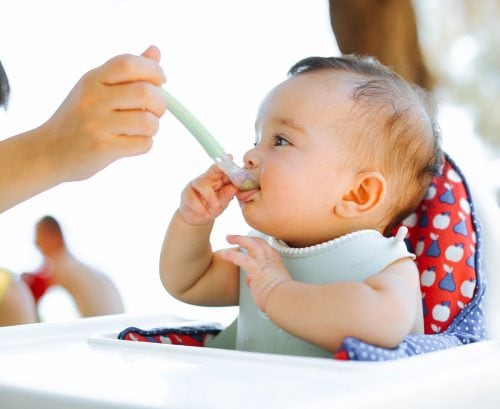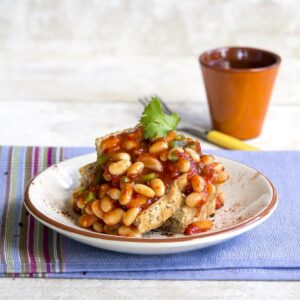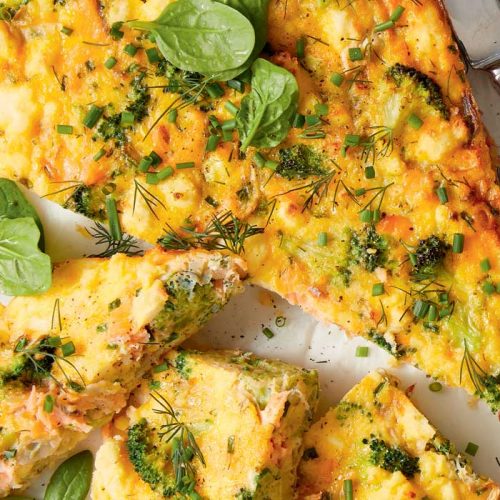
Starting your baby on solids is an exciting milestone and marks the beginning of a long and tasty food journey. Dietitian and new mum Brooke Delfino takes you through the ABCs of starting solids and helps you decide what’s best for your bub.
Like most things baby-related, there’s plenty of conflicting advice when it comes to introducing solids to your baby.
Ask friends and even your mum what they did with their children and, chances are, you’ll receive a raft of differing opinions.
Weaning has changed a lot over the past few generations, and it also differs between cultures. This is a pivotal stage in a baby’s development, so new mums can be forgiven for feeling anxious. We’ve sifted through the latest guidelines to help smooth the way.
Changing advice
Is earlier better? Or is it best to wait? The guidelines have changed a couple of times over the past two decades, but the latest research suggests the best time for introducing your baby to solid foods is at around six months.
Starting too early (before four months) stresses a baby’s immature digestive system. At this crucial stage of development, your baby needs only breast milk or formula, both of which provide sufficient nutrients and energy for growth.
What about allergies?
With food allergies on the rise, many new parents are anxious about introducing potentially allergenic foods.
“Advice around allergies has changed over the years, from delaying introduction until after 12 months to now recommending introducing allergens before 12 months,” says Courtney Bates, accredited practising dietitian and founder of Healthy Bods Nutrition.
In fact, allergy specialists think the old advice to withhold certain foods, such as nuts and eggs, may have partly contributed to the dramatic spike in childhood allergies.
“The nine foods that account for 90 per cent of all food allergy reactions are peanuts, tree nuts, eggs, cow’s milk, wheat, fish, shellfish, soy and sesame,” Bates explains.
If food allergies run in your family, or if you’re at all concerned about your child developing allergies, make an appointment to see a dietitian who specialises in food allergies.
4 signs your baby is ready to start solids
Every baby is different, so be guided by your baby’s individual development and behaviour when trying to work out the best time to start introducing solids. Indications that your baby is ready for solid foods include when he or she…
- Has good head and neck control
- Can sit (with assistance) in a high chair or on your lap
- Shows interest in food and reaches for food
- Opens their mouth when food approaches or when a spoon touches their lips.
4 signs baby isn’t ready to start solids
Equally important is being able to recognise when your baby is not interested in solids or is full. This includes:
- Closing their mouth tightly
- Turning their head away when food is offered
- Crying when food is offered
- Pushing the spoon away.
If you notice any of this behaviour during your first attempt at feeding solids, relax and try again in a few days. Don’t force it if your baby is not interested or getting visibly upset, as this may trigger a negative association with meal times.
How to get started
Your baby will be experiencing a range of new flavours and textures, so expect a range of reactions — and a lot of mess!
4-6 months: Let the fun begin
Ideally, you want to start with an iron-rich food because the supply of iron that babies are born with starts to drop at around six months.
“Baby rice cereal is a great first food as it’s easy to prepare, low allergenic, affordable and fortified with iron,” explains Bates. You might want to dilute rice cereal with breast milk or formula. Other iron-rich foods include meat, chicken and legumes.
“Introduce a variety of different fruit and veg in the first four weeks of starting solids,” suggests Bates. Try one or two teaspoons of a food to start with, then increase according to your baby’s appetite. You can mix first foods together, but it’s advised you only introduce one new allergen at a time.
You can also give your baby pieces of soft food, so they can try feeding themselves.
Food ideas for 4–6-month-olds
- Pureed or mashed fruit (banana, avocado, cooked apple and pear)
- Pureed cooked vegetables (carrots, beans, pumpkin and sweet potato)
- Grains (iron-fortified rice cereal and baby porridge)
- Pureed or minced meat, chicken and fish
7-9 months: Exposure, exposure, exposure
By around eight months of age, your baby will most likely have tried a few different foods and probably even found some favourites. Now is the time to start increasing the quantity and variety of foods in her diet.
She should be easily swallowing mashed foods and starting to chew more solid, finger foods. If your baby refuses a new food, offer it again the following day. Sometimes babies (and young children) need to try a new food more than 10 times before they accept it.
Around this time, you can also offer your baby small amounts of cow’s milk on cereal, as well as custard, cheese and yoghurt. Aim to give two to three solid meals a day, but keep breast milk or formula as your baby’s primary source of nutrition.
Food ideas for 7–9-month-olds
- Chopped and finger foods, such as pieces of tender meat, well-cooked fish, cooked vegetables, soft diced fruit and bread crusts to encourage chewing and self-feeding
- Fresh fruit (banana divided into thirds, individual raspberries, slices of kiwifruit, watermelon, mango and peach)
- Pasta and rice as part of mixed dishes, such as bolognese and risotto
- Omelettes and scrambled eggs
- Yoghurt and cheese
12+ months: Same food, same time
By the time your baby is 12 months old, he should be eating the same foods as the rest of the family. You might still need to chop certain foods into smaller pieces, and cook vegetables until they’re soft. At around this age he should be eating three main meals and two to three snacks a day.
Babies learn to eat by watching their family eat. Talk with your baby about the food he is eating: what it is, its colour, how it tastes, where it grows and how you cooked it.
Giving your baby the same foods as the rest of the family will encourage him to try different foods — monkey see, monkey do!
Food ideas for 12+-month-olds
- Mixed dishes such as risotto, pasta, slow-cooked meats and vegetables
- Mini meatballs, savoury muffins and vegetable slices
- Omelettes, scrambled egg and frittatas
- Sandwiches with fillings like avocado, cheese, nut butters, tuna and hoummos
- Fresh fruit and vegetables
- Fruit smoothies
Help! I’m terrified of my baby choking
Before you panic, be aware that gagging is a very normal developmental response in babies. The gag reflex is a protective mechanism to help prevent choking, and in young babies is very far forward in the mouth. Gagging and coughing is a sign your baby is bringing food forward in their mouth and away from their airways so they don’t choke.
Before you start the solids journey, take an infant CPR class and learn the difference between gagging and choking, and what to do if choking occurs. The best way to prevent choking is to offer your baby texture-appropriate foods for their age.
“If you’re offering finger foods, be sure they’re cooked so they’re soft enough to squish between your thumb and forefinger, and offer them in long, thin sticks,” Bates recommends.
Foods that are choking risks and not suitable for babies under the age of 12 months are:
- Whole nuts
- Whole grapes
- Whole cherry tomatoes
- Popcorn
- Marshmallows
- Large pieces of raw apple and carrot
- Large, tough chunks of meat
- Fruit pips and stones
- Sausages.
Real-life story
As a dietitian and editor of HFG Australia, I was enthusiastic about Lila starting solids. Yet, despite my knowledge, I still felt daunted as our solids journey was not as smooth as I was hoping, or expecting.
At about five months, Lila started showing the typical signs of readiness: good head and neck control, sitting well and plenty of interest in what we were eating. I did my research and decided to introduce purees, then slowly progress to finger foods. I spent all weekend making batches of fruit and vegetable purees to freeze, set up the highchair and sterilised spoons. We were ready! Or so I thought.
Lila’s first taste of pureed pumpkin was typical of how most babies initially react to solids. Lots of funny faces and plenty of mess! We offered small amounts every day, and by the fourth day, Lila would flatly refuse and cry when the spoon came out.
I was disheartened and confused. This was meant to be fun!?
After some thought, I decided she wasn’t quite ready and waited another three to four weeks before trying again. This time around, she was much more accepting, but still didn’t like being fed with a spoon. Instead, I offered strips of avocado, banana broken into thirds, soft pieces of roasted pumpkin and toast crusts, and suddenly she loved it – and couldn’t get enough! This was great, except my fear of her choking made mealtimes stressful. To help with my anxiety, I did my infant first aid course and learnt the difference between gagging (normal) and choking (not normal). My fear dissipated and we started our solids journey primarily with baby-led weaning (finger foods), plus a few purees here and there when I could get them in.
Fast forward nine months and Lila is happy and healthy, and loves her food. Her favourites are avocado, yoghurt, spag bol, raspberries, bananas and scrambled eggs. There are still days where she refuses foods, or I worry she’s not eating enough veg but, overall, she’s meeting her nutrient needs. Plus we’re having fun trying new foods and enjoying meals together as a family!
Brooke’s top three tips for starting solids
- Lower expectations Don’t expect your baby to take to a food the first time — or even the tenth time! — you offer it. Acquiring a taste for certain foods can be a slow process, and that’s okay. Remind yourself that your baby is learning a new skill, so be patient, keep offering and remove the pressure.
- Don’t compare Every baby is different, so every solids journey is different. What works for someone else’s baby might not work for yours, so trust your gut and follow your baby’s cues.
- Keep it simple It’s not about preparing fancy, Instagram-worthy meals day after day. Some of the simplest meals are the most nutritious. Think scrambled eggs and avocado on toast, bolognese, pasta, roasted pumpkin and sweet potato, porridge or Weet-Bix, and frittata with leftover veggies.
What is baby-led weaning?
Baby-led weaning (BLW) is a way of introducing solids without spoon-feeding puree. Instead, you offer suitable finger foods from everyday family meals, such as steamed carrot or broccoli, pieces of avocado or roast pumpkin, and strips of steak. The BLW method encourages independence and fine and gross motor skills, as bub feeds himself with his hands, then later with cutlery. The negatives? It’s messy and hard to know much is being eaten, since a lot of food ends up on the floor. Also, iron needs might not be met, since babies can’t properly chew meat.
Article sources and references
- Australasian Society of Clinical Immunology and Allergy. 2020. How to introduce solid foods to babies for allergy prevention — frequently asked questions (FAQ). Accessed July 2021 https://www.allergy.org.au/about-ascia/info-updates/updated-ascia-faq-how-to-introduce-solid-foods-for-allergy-prevention
- Australian Breastfeeding Association. 2021. Confused about introducing solids? Accessed July 2021. https://www.breastfeeding.asn.au/bf-info/weaning-and-introducing-solids/solidsconfusion
- Better Health Channel. 2021. Introducing solid foods for babies. Accessed July 2021. https://www.betterhealth.vic.gov.au/health/healthyliving/eating-tips-for-babies
- National Health and Medical Research Council. 2012. Infant feeding guidelines. Australian Government, Canberra. Accessed July 2021. https://www.eatforhealth.gov.au/sites/default/files/files/the_guidelines/n56_infant_feeding_guidelines.pdf
- Netting et al. 2017. An Australian consensus in infant feeding guidelines to prevent food allergy: Outcomes from the Australian Infant Feeding Summit. J Allergy Clin Immunol Pract. 5(6): 1617–24.https://pubmed.ncbi.nlm.nih.gov/28499774/
- Raising Children Network Australia. 2019. Making family meals enjoyable: six tips. Accessed July 2021. https://raisingchildren.net.au/teens/family-life/family-meals-cooking/family-meals-tips
www.healthyfood.com










